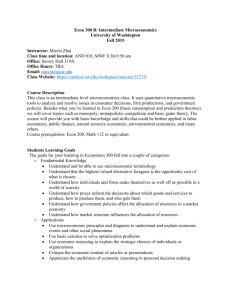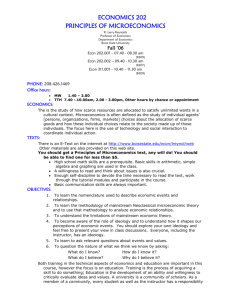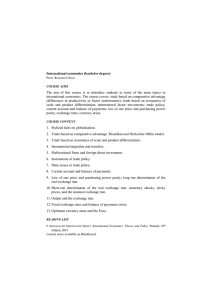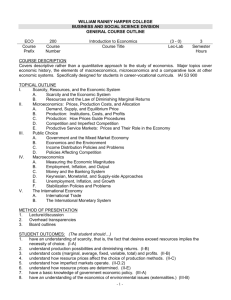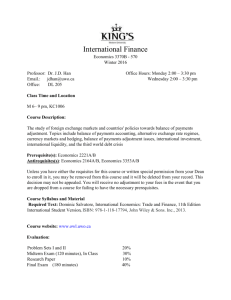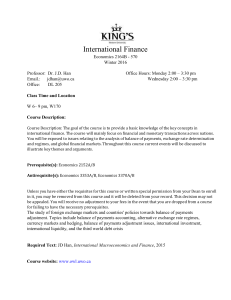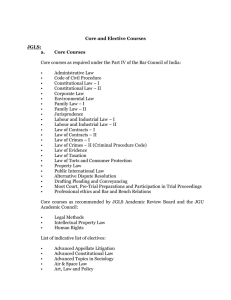International Economics
advertisement
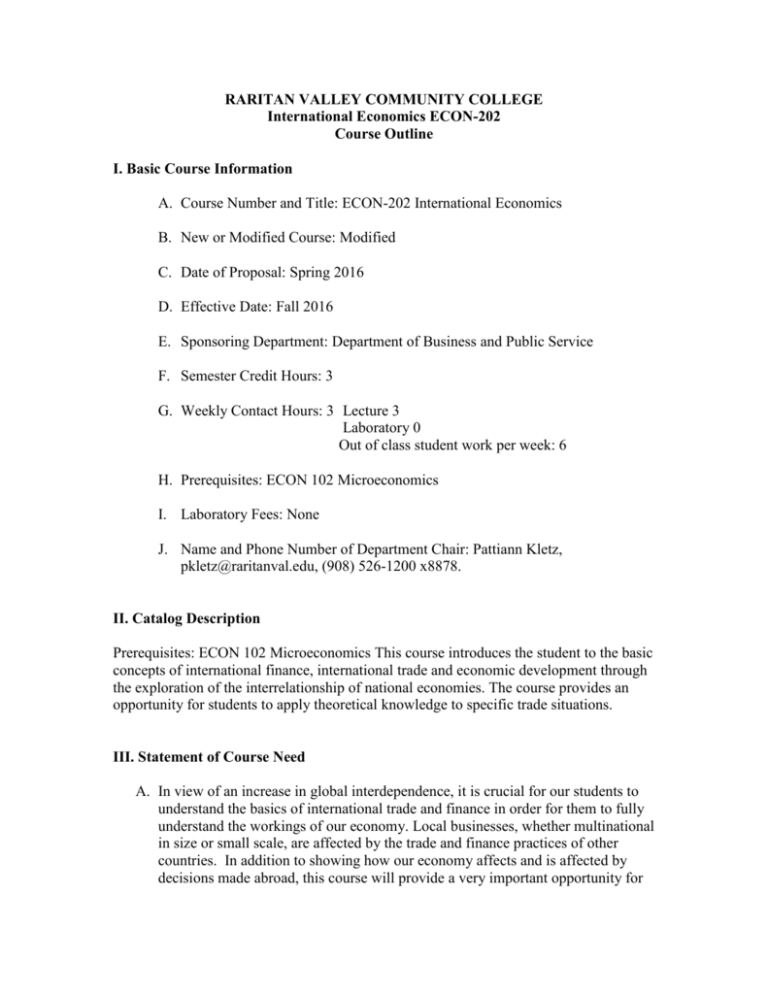
RARITAN VALLEY COMMUNITY COLLEGE International Economics ECON-202 Course Outline I. Basic Course Information A. Course Number and Title: ECON-202 International Economics B. New or Modified Course: Modified C. Date of Proposal: Spring 2016 D. Effective Date: Fall 2016 E. Sponsoring Department: Department of Business and Public Service F. Semester Credit Hours: 3 G. Weekly Contact Hours: 3 Lecture 3 Laboratory 0 Out of class student work per week: 6 H. Prerequisites: ECON 102 Microeconomics I. Laboratory Fees: None J. Name and Phone Number of Department Chair: Pattiann Kletz, pkletz@raritanval.edu, (908) 526-1200 x8878. II. Catalog Description Prerequisites: ECON 102 Microeconomics This course introduces the student to the basic concepts of international finance, international trade and economic development through the exploration of the interrelationship of national economies. The course provides an opportunity for students to apply theoretical knowledge to specific trade situations. III. Statement of Course Need A. In view of an increase in global interdependence, it is crucial for our students to understand the basics of international trade and finance in order for them to fully understand the workings of our economy. Local businesses, whether multinational in size or small scale, are affected by the trade and finance practices of other countries. In addition to showing how our economy affects and is affected by decisions made abroad, this course will provide a very important opportunity for our students to apply the theoretical knowledge acquired in Macroeconomics and Microeconomics to specific trade situations. An international economics course will not only be an important boost to the economics curriculum, but will also strengthen the business program in general since it will expand the student's knowledge of how business is conducted globally. Increasingly, more and more international businesses are located in our area. These businesses will need workers who have a basic knowledge of the workings of the global economy. B. This course does not have a lab. C. This course generally transfers as a business/economics program elective. IV. Placement of Course in College Curriculum A. Free elective B. The course meets a Business Elective. C. The course meets a program requirement for the International Business Option in Business Management AAS Degree, International Business Option in Business Administration AS and International Business Certificate Programs. D. Course transferability; for New Jersey schools go to the NJ Transfer website, www.njtransfer.org. For all other colleges and universities go their individual websites. V. Course Content A. International Finance 1. Foreign Exchange a. Basic Introduction b. Government Intervention 2. Balance of Payments 3. Effects of Domestic Activities a. Balance of Payments b. Exchange Rates 4. International Monetary Relations B. International Trade 1. Why Nations Trade 2. Trade Barriers and Promotion 3. Trade Patterns 4. History of US Trade Practices 5. Current US Trade Issues C. Economic Development 1. Human Resource Development 2. Trade Development 3. Industrialization 4. Agricultural Development VI. General Educational and Course Learning Outcomes A. General Education Learning Outcomes At the completion of this course, students will be able to: 1. Critically evaluate international trade and finance theory. (G.E. NJ 5) 2. Discuss with others in a clear, logical manner international trade and finance issues as they apply to the real world.. (G.E. NJ 2) 3. Evaluate ethical issues that face businesses as they work in the international field. (ER) 4. Apply quantitative reasoning to interpret trade and business data. (G.E. NJ 2) B. Course Learning Outcomes At the completion of this course, students will be able to: 1. Explain international trade terms such as export, import, balance of payments, and balance of trade. 2. Report on the effects on the national economy of balance of payments and the balance of trade surpluses and deficits. 3. Analyze various types of exchange rates. 4. Differentiate between different theories of how nations trade. 5. Analyze various types of trade barriers. 6. Analyze when to use various theories of why nations trade. 7. Examine the advantages and disadvantages to protectionism and free trade. 8. Examine what economic development means and what its importance is to some nations. 9. Examine various ways developing countries have attempted to expand and modernize their economies. 10. Illustrate why one exchange rate method would be preferred to another. C. Assessment Instruments 1. Examinations (Required) 2. Oral presentations 3. Research reports VII. Grade Determination A. Examinations (Required) B. Oral presentations C. Research reports Given the goals and outcomes described above the primary modes of teaching will be: A. Lecture/discussion B. Small group work C. Guest speakers D. Student oral presentation VIII. Text and Materials Textbook: Author(s): James Gerber Title: International Economics Publisher: Addison Wesley Issue: Latest Please note: The course outline is intended only as a guide to course content and resources. Do not purchase textbooks based on this outline. The RVCC Bookstore is the sole resource for the most up-to-date information about textbooks. IX. Resources In addition to a regular classroom, this course will require the use of the library.





